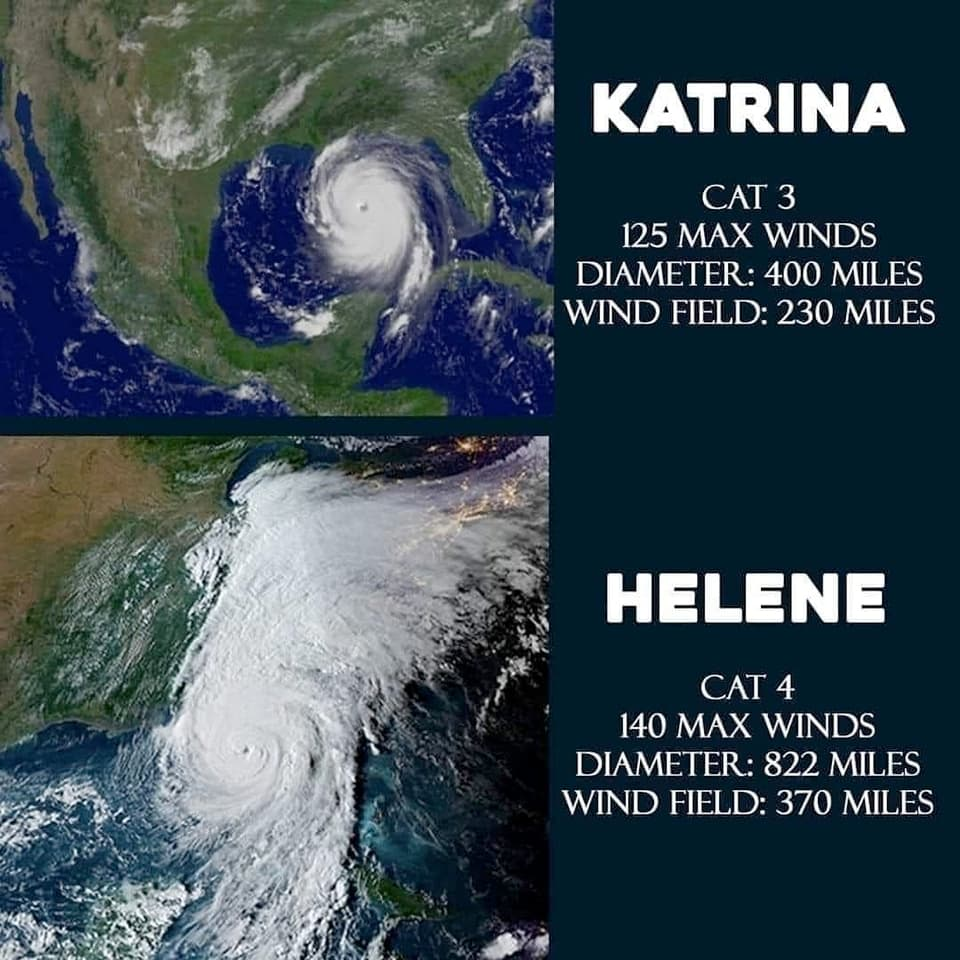this post was submitted on 05 Oct 2024
918 points (94.4% liked)
science
14875 readers
74 users here now
A community to post scientific articles, news, and civil discussion.
rule #1: be kind
<--- rules currently under construction, see current pinned post.
2024-11-11
founded 2 years ago
MODERATORS
you are viewing a single comment's thread
view the rest of the comments
view the rest of the comments

Helene’s size shocked me but the storm surge for Katrina was unusually extreme. It was a well organized Category 5 and then weakened to a strong 3 right before landfall.
To compare with Helene, which was similar in terms of (east to west) diameter but covered much more area overall, with category 4 winds at landfall: the Weather Channel was making a big deal out of the 8ft storm surges. During Katrina, the Mississippi Gulf Coast had a 28 foot storm surge. (The Miss. Gulf Coast isn’t that geographically different from the Fla. big bend region but that plays a role too.)
Helene’s unusual movement speed kept it strong very far inland and caused massive issues in places that rarely see tropical weather. Harvey was the opposite: it stalled over Houston and dumped days of rain on a major metropolis.
I wish we could update the Saffir Simpson scale to something that takes into account more variables. There are other measurements but no storm is identical in terms of damage potential. A category 5 can not even make landfall whereas something like Hurricane Sandy was a category 1 (or equivalent since it wasn’t technically still a hurricane) when it hit NYC and caused massive damage and flooded subway systems. Sometimes, a storm hitting a place that isn’t used to them can knock over all the trees or flood rivers while a similar storm would be nothing to Miami or New Orleans.
What surprised me most about Helene was the ground speed. I don't remember seeing any hurricane make landfall in the US moving at over 20mph. As a casual observer I have anyways seen 12 mph as a quick storm and 6 mph as slow.
Yeah, I’ve lived in New Orleans or on the East Coast my whole life and don’t recall that sort of movement speed. Usually, you want a fast moving storm so no one area takes on all the rain but Helene was going so fast and was so massive that it’s probably unprecedented.
Helene is more deadly than Katrina if you don't count the deaths after the boat broke the levee that was well beyond its lifespan in New Orleans, which you shouldn't since that was a 100% fixable issue that was not taken care of.
We always say Katrina was a man-made disaster. I worry with climate change, that other places will be testing their infrastructure. Katrina should have been the canary in the coal mine and a lot of people just said, “Don’t live below sea level.” Old river damns can break just as easily as neglected levees.
It was definitely a man-made disaster when it came to New Orleans. I made this analogy to someone else: if lightning strikes a skyscraper and the skyscraper burns down and kills everyone inside due to a lack of a sprinkler system, is that really death by a natural cause? I would say it's death by gross incompetence.
But we couldn't have the poor corporation taking the responsibility for that. They'd never get their insurance pay out! And after all that work disabling the sprinkler system and installing extra metal antennae in the roof...
We don't respect rivers enough. I would never live in a floodplain.
The real problem with "never live on a floodplain" is that you can't know where the floodplains are. The flood maps are all based on historical rainfall data, and that data is now obsolete. Even worse, it won't stabilize in our lifetimes. So we can't just observe the next ten years of rainfall and plan around that. No, things are changing, and they will continue to change. You might think you don't live on a 500 year floodplain. But the cold truth of it is, we no longer have any idea where the 500 year flood plains are anymore. You need decades of weather observations of a stable climate to come up with accurate flood maps. And we just don't have that kind of reliable data anymore. Unless you happen to live on the top of a very tall hill, you really can't be sure you don't live in a flood zone of some sort or another.
I live on top of a hill that drains directly into the ocean. If my house floods I have different problems.
I also won't live on the side of hills without a very clear understanding of the local watershed, soil stability, nearby land rights... I took a lot of Earth science classes and honestly it's kinda traumatizing to peek behind the curtain. Shit is fucked.
What boat?
https://en.wikipedia.org/wiki/ING_4727
Wiki says the barge didn't cause the break in the levee, so it was entirely forseeable due to lack of maintenance